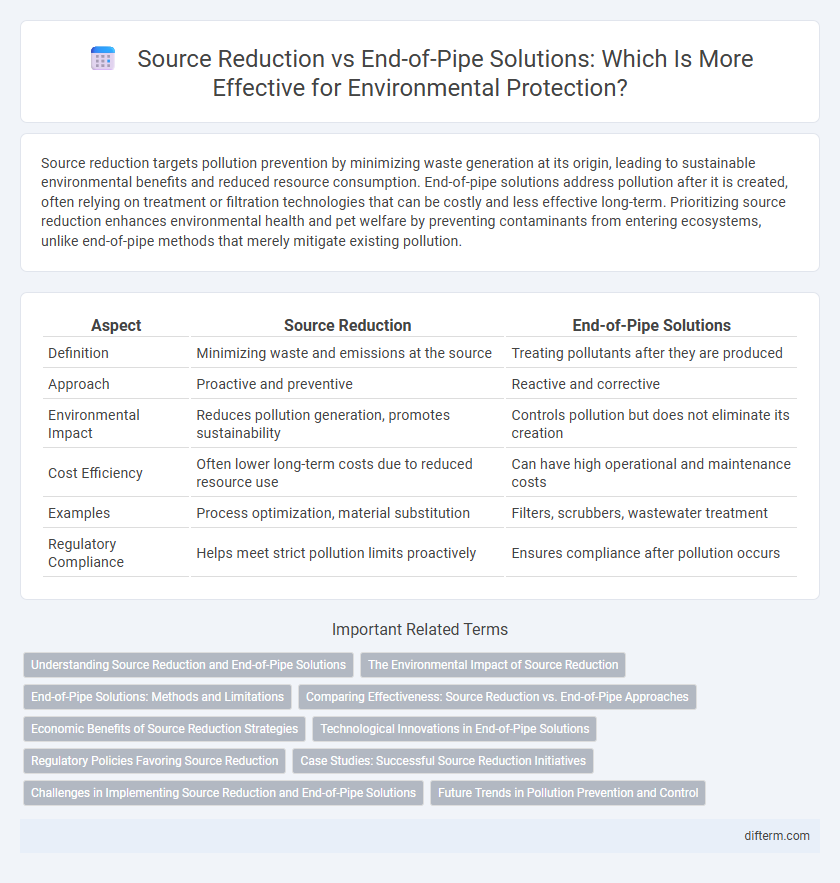Source reduction targets pollution prevention by minimizing waste generation at its origin, leading to sustainable environmental benefits and reduced resource consumption. End-of-pipe solutions address pollution after it is created, often relying on treatment or filtration technologies that can be costly and less effective long-term. Prioritizing source reduction enhances environmental health and pet welfare by preventing contaminants from entering ecosystems, unlike end-of-pipe methods that merely mitigate existing pollution.
Table of Comparison
| Aspect | Source Reduction | End-of-Pipe Solutions |
|---|---|---|
| Definition | Minimizing waste and emissions at the source | Treating pollutants after they are produced |
| Approach | Proactive and preventive | Reactive and corrective |
| Environmental Impact | Reduces pollution generation, promotes sustainability | Controls pollution but does not eliminate its creation |
| Cost Efficiency | Often lower long-term costs due to reduced resource use | Can have high operational and maintenance costs |
| Examples | Process optimization, material substitution | Filters, scrubbers, wastewater treatment |
| Regulatory Compliance | Helps meet strict pollution limits proactively | Ensures compliance after pollution occurs |
Understanding Source Reduction and End-of-Pipe Solutions
Source reduction focuses on minimizing waste and pollution at the origin by altering production processes and material use, thereby preventing environmental impact before it occurs. End-of-pipe solutions involve treating pollutants after they have been created, using technologies such as filters and scrubbers to reduce emissions and contamination. Prioritizing source reduction is more sustainable and cost-effective, as it addresses the root cause of pollution rather than managing its consequences.
The Environmental Impact of Source Reduction
Source reduction significantly mitigates environmental damage by minimizing waste and pollution at their origin, thereby conserving resources and reducing greenhouse gas emissions. This proactive approach lessens the burden on treatment facilities and decreases the need for energy-intensive end-of-pipe solutions. Implementing source reduction strategies enhances ecosystem resilience and promotes sustainable resource management, resulting in long-term environmental benefits.
End-of-Pipe Solutions: Methods and Limitations
End-of-pipe solutions involve treating pollutants after they have been generated, using technologies like scrubbers, filters, and wastewater treatment plants to reduce emissions and effluents before release into the environment. These methods effectively minimize environmental damage but often incur high operational costs and do not address the root cause of pollution. Limitations include the potential for incomplete pollutant removal and reliance on ongoing maintenance, making source reduction a more sustainable long-term strategy.
Comparing Effectiveness: Source Reduction vs. End-of-Pipe Approaches
Source reduction addresses pollution by minimizing waste and emissions at their origin, making it a proactive environmental strategy. End-of-pipe solutions focus on treating pollutants after they are generated, often involving filtration, scrubbing, or containment technologies that prevent contaminants from entering the environment. Studies show source reduction generally offers greater long-term effectiveness and cost-efficiency by eliminating pollutants before they require remediation, while end-of-pipe measures serve as reactive interventions that may reduce immediate impact but do not prevent pollution formation.
Economic Benefits of Source Reduction Strategies
Source reduction strategies in environmental management significantly lower operational costs by minimizing waste generation and reducing raw material consumption. Businesses witness enhanced resource efficiency and reduced expenses related to waste treatment, disposal, and regulatory compliance. These proactive measures foster sustainable economic growth by preventing pollution at its origin rather than relying on costly end-of-pipe solutions.
Technological Innovations in End-of-Pipe Solutions
Technological innovations in end-of-pipe solutions have significantly improved the capture and treatment of pollutants before they reach the environment, utilizing advanced filtration systems, catalytic converters, and real-time monitoring sensors. These technologies enhance efficiency in reducing emissions and wastewater contaminants in industries such as power generation and manufacturing, mitigating environmental impact without altering production processes. Despite these advancements, end-of-pipe solutions complement but do not replace source reduction strategies, which address pollution prevention at its origin.
Regulatory Policies Favoring Source Reduction
Regulatory policies increasingly favor source reduction as a proactive environmental strategy by minimizing waste generation and pollutant emissions at their origin, leading to more sustainable industrial practices. Source reduction policies incentivize innovation in cleaner technologies and materials, reducing reliance on costly end-of-pipe treatment systems like scrubbers and filters. Governments such as the EPA implement frameworks like the Pollution Prevention Act, prioritizing source reduction to enhance resource efficiency and lower environmental impact compared to traditional remediation methods.
Case Studies: Successful Source Reduction Initiatives
Case studies from industries such as manufacturing and chemical production highlight significant environmental benefits achieved through source reduction initiatives that minimize waste generation at the outset. For example, Toyota's implementation of lean manufacturing practices resulted in up to a 90% reduction in paint waste, dramatically lowering hazardous emissions and disposal costs. These successful source reduction efforts demonstrate superior long-term sustainability compared to traditional end-of-pipe solutions, which primarily address pollution only after it has been created.
Challenges in Implementing Source Reduction and End-of-Pipe Solutions
Source reduction faces challenges such as high initial costs, technological limitations, and resistance from industries due to changes in production processes. End-of-pipe solutions often struggle with inefficiencies in pollutant capture, ongoing maintenance expenses, and potential secondary pollution. Regulatory hurdles and lack of stakeholder engagement further complicate the implementation of both strategies in environmental management.
Future Trends in Pollution Prevention and Control
Source reduction strategies focus on minimizing waste and emissions at the origin by redesigning processes and materials, offering long-term sustainability compared to end-of-pipe solutions that treat pollutants after generation. Emerging trends emphasize advanced digital technologies such as AI and IoT for real-time monitoring and adaptive emission control, enhancing source reduction efficacy. Renewable energy integration and circular economy principles further drive innovation in pollution prevention, reducing dependency on traditional pollution control systems.
source reduction vs end-of-pipe solutions Infographic

 difterm.com
difterm.com